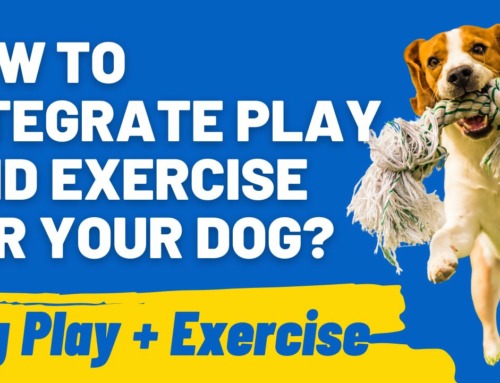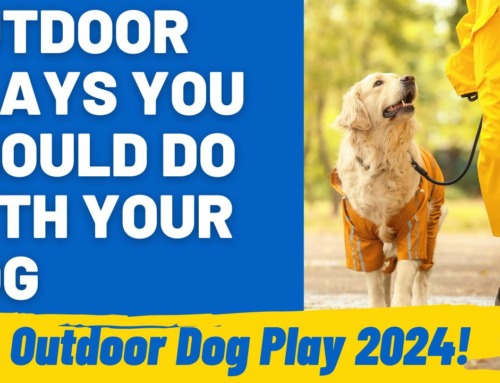Engaging your furry friend in playful activities indoors can be a game-changer for their well-being and your bond.
I recall the time when my Cavoodle, Bobby, looked up at me with those eager eyes, yearning for adventure but the rain outside had other plans.
It was then I realized the true value of indoor dog play ideas—not just as a pastime but as a vital aspect of his mental and physical health.
In this comprehensive guide, we’ll dive into the world of indoor play, uncovering the secrets to keeping your dog entertained, stimulated, and joyful, all within the comfort of your home.
Here’s a glimpse of what we’ll cover:
- The importance of indoor play for dogs, highlighting its role in mental stimulation, physical health, and strengthening the pet-owner bond.
- A variety of play types that cater to your dog’s needs, from mental exercises and physical activities to interactive games that challenge their intellect.
- Strategies for transforming your home into a fun and safe play zone, ensuring an exciting environment for your dog’s adventures.
- Creative play ideas that you can implement right away, ranging from interactive games to DIY toys and games, all designed to spark curiosity and engagement.
Whether you’re looking for ways to keep your dog active during bad weather or simply want to introduce more fun into their daily routine, this article promises to deliver valuable insights and practical tips to enhance your indoor playtime.
Let’s make every moment inside a memorable adventure for our canine companions.
Why Are Indoor Dog Play Ideas Important for Your Furry Friend?
Indoor play is not just used for pet entertainment; it is an essential aspect of a dog’s overall well-being.
One of the primary benefits of indoor play is mental stimulation. Dogs are intelligent animals that require mental engagement to stay happy and healthy.
Without adequate stimulation, dogs can develop behavioral issues such as excessive barking, digging, or even anxiety. Indoor play activities, especially those that challenge their minds, can help keep their brains active and engaged.
Physical health is another crucial element. While outdoor canine activities are great for exercise, indoor play ensures that your dog stays active regardless of weather conditions or other external factors.
Regular play helps maintain a healthy weight, strengthens muscles, and improves cardiovascular health. It’s especially beneficial for dogs living in urban areas where outdoor space may be limited.
Lastly, indoor play significantly strengthens the bond between pets and their owners. Engaging in creative playtime together builds trust and understanding, enhances communication, and provides an opportunity for positive interactions.
This bonding time is invaluable for developing a strong, loving relationship with your furry friend.
What Types of Play Cater to a Dog’s Needs?
Mental Exercises
Mental stimulation is crucial for a dog’s cognitive development and overall happiness. Puzzle toys, teaching new tricks, and hide-and-seek puppy games are excellent ways to challenge your dog’s mind.
These fun activities keep them engaged, reduce boredom, and can even help mitigate destructive behaviors.
Physical Activities
Physical play is essential for maintaining your dog’s health and fitness. Indoor fetch, tug-of-war, and creating small obstacle courses are great ways to keep them active.
These activities not only provide indoor exercise but also help in muscle development and coordination.
Interactive Games
Combining both mental and physical stimulation, interactive games are a comprehensive way to cater to your dog’s needs.
Games like find-the-treat, interactive toys that require problem-solving for rewards, or gentle wrestling can provide the mental challenge and physical engagement your dog craves.
How Can You Turn Your Home Into a Fun Play Zone?
Designate a Play Area
Choose a specific area in your home for playtime. This could be a spare room, a corner of the living room, or any space that can be safely dedicated to your dog’s activities. Ensure it’s free from hazards and has enough room for your dog to move around.
Safety First
Remove any dangerous items like sharp objects, breakables, or small items that could be swallowed. Make sure the play area is dog-proofed, with secure windows and doors to prevent any accidents.
Rearrange Furniture
Consider rearranging furniture to create more open space for active play. This could involve moving a coffee table to the side or clearing a hallway for a game of fetch.
Soft Surfaces
Place rugs, mats, or dog beds to provide a comfortable and safe surface for your dog to play on. This is especially important for older dogs or breeds with joint issues.
Use Specific Rooms
Some activities might be better suited to specific rooms. For example, a kitchen or bathroom might be ideal for messy water play or treat-hunting games.
Create Obstacle Courses
Use household items like chairs, blankets, and cushions to create fun and challenging obstacle courses. This not only provides physical exercise but also mental stimulation as your dog navigates through the course.
Interactive and Engaging Toys
Invest in toys that are specifically designed for indoor play and dog enrichment. These can include treat-dispensing toys, chew toys, and puzzle games that keep your dog entertained and engaged while indoors.
What Are Some Creative Indoor Dog Play Ideas?
Indoor play is not just a way to keep your dog entertained; it’s an opportunity to stimulate their mind, improve their physical health, and strengthen your bond. Here are various indoor play ideas that are both fun and beneficial for your furry friend.

Interactive Games: What Works Best?
- Hide and Seek: This timeless game enhances your dog’s problem-solving skills and strengthens your bond. Start by asking your dog to stay, then hide yourself or a toy and call them to find you. Reward them when they succeed to encourage participation.
- Puzzle Toys: These toys are designed to challenge your dog’s brain and are great for mental stimulation. They come in various forms, like sliding puzzles or toys that require your dog to lift or push pieces to uncover treats.
- Treat Hunts: Hide treats around your home and encourage your dog to sniff them out. This game taps into their natural scavenging instincts and provides both mental and physical exercise.
Training as Play: Can Learning Be Fun?
Turning training sessions into playful experiences can be incredibly rewarding and fun. Use positive reinforcement such as treats, praise, or play to encourage your dog.
Focus on teaching simple tricks like ‘shake hands’, ‘roll over’, or ‘play dead’, which can be fun and mentally stimulating for your dog.
Incorporate games into training, like using fetch to reinforce the ‘come’ command. This approach keeps the training light-hearted and enjoyable, reinforcing learning as a positive and fun activity.
DIY Dog Toys and Games: What Can You Create?
Engaging your dog’s mind and body doesn’t have to be expensive. You can create effective toys with items around your house:
- Bottle Spin Game: Take an empty plastic bottle, put some treats inside, and suspend it so that it can spin. Your dog will have to figure out how to spin the bottle to get the treats out.
- Tug Toys from Old Clothes: Use old t-shirts or towels to create tug toys. Braid strips of fabric tightly together for a durable and washable toy.
- Box Puzzle: Take a cardboard box and fill it with balls or crumpled paper. Hide treats inside for your dog to find. This encourages exploration and problem-solving.
How to Keep Play Safe and Enjoyable?
Creating a safe and enjoyable environment for home play is crucial for your dog’s well-being. Here are some guidelines to ensure that playtime is both fun and secure:
- Choose Appropriate Toys: Select toys that are suitable for your dog’s size and chewing habits. Avoid toys with small, detachable parts that could become choking hazards. Regularly inspect toys for any signs of wear and tear, and replace them as needed.
- Supervise Playtime: Always supervise your dog during playtime to ensure they are playing safely. Watch out for any signs of overexcitement or aggression, especially when introducing new toys or games.
- Create a Safe Play Area: Ensure the play area is free from hazards such as sharp objects, toxic substances, or small items that could be ingested. Use gates or barriers if necessary to confine the play space.
- Understand Your Dog’s Limits: Pay attention to your dog’s body language and energy levels. Some dogs may not know when to stop playing, leading to exhaustion, injury, or excessive energy burn. Take breaks and provide a quiet space for your dog to rest.
- Regular Playtime Schedule: Establish a routine for playtime. Consistent schedules help your dog understand when it’s time to play and when it’s time to relax, preventing hyperactivity.
Can Indoor Play Help with Specific Behavioral Issues?
Indoor play is not just a source of fun for dogs; it’s an effective tool for addressing and managing various behavioral issues.
Understanding the role of play in modifying behavior can help create a more harmonious environment for both pets and their owners.
Anxiety
Dogs often experience anxiety, which can manifest in various ways, including destructive behavior, whining, or restlessness.

Interactive play can significantly reduce anxiety by providing mental stimulation and keeping your dog’s mind engaged.
Excessive Barking
Excessive barking is a common issue that can stem from boredom, attention-seeking, or stress.
Regular, engaging play sessions can help mitigate this behavior by channeling your dog’s energy into positive activities. Play provides both physical exercise and mental engagement, reducing the pent-up energy that can lead to incessant barking.
HoundGames offers an array of products that can help in this regard.
Our Dog Puzzle Toys, for example, are excellent for mental engagement. As your dog solves the puzzles, they are rewarded with treats, which helps to reduce the likelihood of excessive barking due to boredom or stress.
Additionally, HoundGames’ Bark Corrector can be a useful tool for managing excessive barking. This humane bark control device emits a harmless noise to interrupt barking, training your dog in a safe and effective way.
Chewing
Inappropriate chewing is another behavioral challenge that many dog owners face. This behavior can be driven by boredom, teething (in puppies), anxiety, or simply the natural instinct to chew.
Providing chew toys during playtime can effectively redirect this behavior. Choose toys that are durable, safe, and appealing to your dog.
HoundGames’ Puppy Toy Mat with Teething Chew Toys is an ideal solution, especially for puppies who are teething.
This all-in-one product includes multiple chew and rope toys, as well as a nose squeaker, which stimulates your dog’s senses and reduces boredom and anxiety.
Separation Anxiety
Dogs with separation anxiety exhibit distress and behavior problems when left alone. Interactive play can help prepare your dog for times when they are alone.
Engaging in mentally stimulating play before leaving the house can tire your dog out and make them more likely to rest while you’re away.
Comparing Different Indoor Play Ideas
| Play Idea | Ease of Setup | Cost | Space Required | Benefits |
| Puzzle Toys | Easy | Low-Medium | Minimal | Mental stimulation, reduces boredom |
| Tug of War | Easy | Low | Moderate | Physical exercise, strengthens bond |
| Hide and Seek | Easy | None | Moderate-Large | Mental and physical stimulation |
| Treat Hunts | Easy | None | Moderate | Encourages natural foraging |
| DIY Obstacle Course | Moderate | Low | Large | Physical exercise, mental challenge |
| Trick Training | Moderate | None | Moderate | Mental stimulation, improves obedience |
This table provides a quick overview of various indoor play ideas, making it easier for dog owners to choose activities that suit their situation and their dog’s needs.
By considering factors like ease of setup, cost, and space required, you can select the most appropriate and enjoyable activities for your pet.
How to Keep the Momentum: Varying Your Indoor Play Routine
Keeping indoor play exciting and fresh is key to maintaining your dog’s interest and enthusiasm. One effective strategy is to rotate their toys.
This doesn’t mean you need a large collection; rather, it’s about reintroducing toys after a period of absence, which makes them feel new and exciting again.
Additionally, try introducing new games and challenges regularly. This could mean teaching a new trick, setting up a different obstacle course, or experimenting with new interactive toys.
Changing the play area can also add a sense of novelty. If you usually play in the living room, try moving to another room or rearranging the space. This change in environment can stimulate your dog’s curiosity and engagement.
Remember, the goal is to keep your dog guessing and excited about what’s coming next, making each play session something they look forward to.
What About Puppies: Tailoring Play for the Younger Ones?
When it comes to puppies, playtime should be tailored to their developmental stage and safety needs.
Puppies are in a crucial stage of growth and learning, so play should focus on aiding their development while ensuring their safety. Choose softer, smaller toys that are appropriate for their size and delicate teeth.
Avoid overly strenuous activities that could harm their developing joints and bones. Instead, focus on gentle play that encourages exploration and learning.
Short, frequent play sessions are also better suited for puppies, as they have limited attention spans and tire quickly.
Furthermore, introduce basic training games to instill good habits from an early age. Remember, playtime for puppies isn’t just about physical exercise; it’s an essential part of their socialization and learning process.
It’s important to monitor their reactions and adjust the play accordingly, ensuring it remains a positive and enriching experience for them.
Conclusion
Discovering and implementing engaging indoor dog play ideas is essential for the overall well-being of your pet.
Through a blend of interactive games, training activities, and creative DIY projects, you can ensure that your dog stays mentally stimulated and physically active, even within the confines of your home.
The various play options discussed not only cater to different dog personalities and energy levels but also address specific behavioral issues and development stages.
By regularly introducing new challenges and rotating toys, you can keep indoor playtime fresh and exciting.
The goal here is to create a fun, safe, and stimulating environment that strengthens the bond between you and your furry friend. With these ideas, you’re well-equipped to provide your dog with a fulfilling and joyful indoor play experience.




